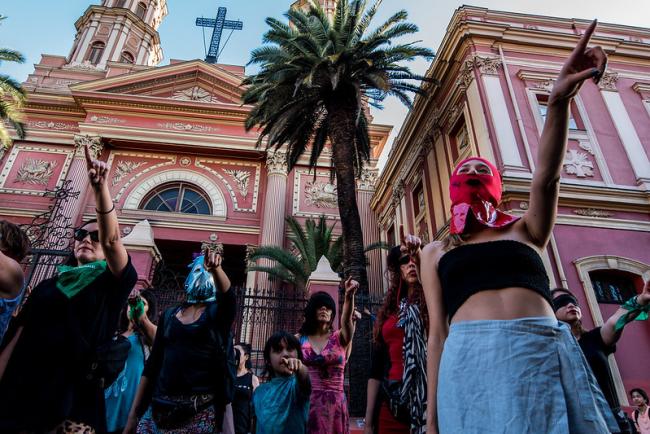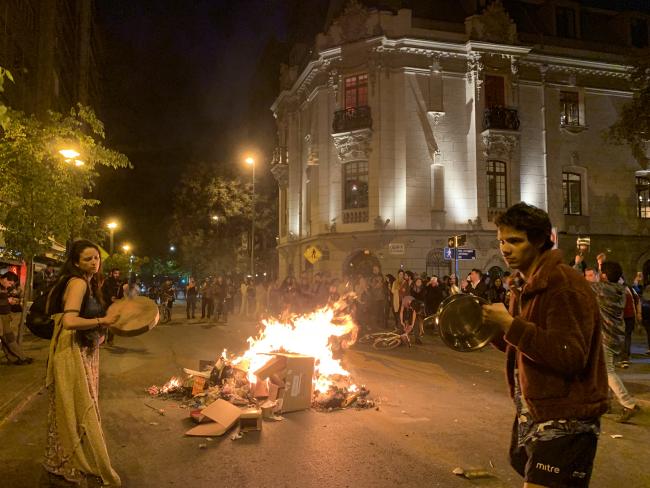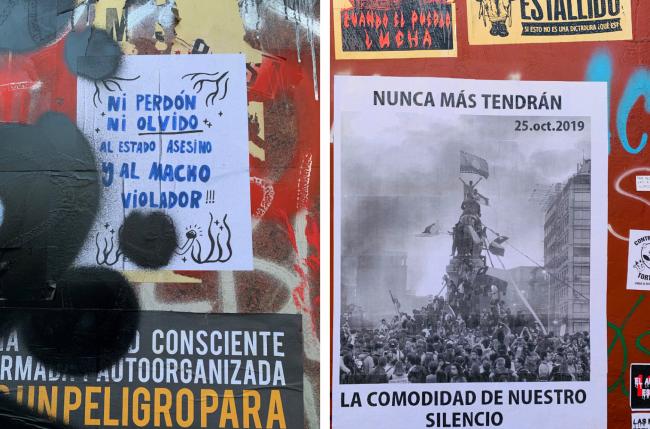
This December, we are asking readers to make a tax-deductible contribution before the year is over to ensure NACLA continues to provide only the best in progressive news and analysis on Latin America. Visit nacla.org/donate
Cacerolazo, cacerolazo, cacerolazo
Cace, cace, cacerolazo
Cacerolazo, cacerolazo
Cace, cace, cace
Quema, despierta, renuncia Piñera
Por la Alameda, es nuestra La Moneda
Cuchara de palo frente a tus balazo’
¿Y al toque de queda? ¡Cacerolazo!
- Ana Tijoux, “Cacerolazo”
Released on October 20, only days after the initial protests against a fare hike in Santiago paralyzed public transportation, Chilean hip hop artist Ana Tijoux’s song “Cacerolazo” stands among a growing number of instances of art as a means of resistance that has surfaced across Chile. Examples of these manifestations range from music and performance to murals, installations, comics, street and body art, and graffiti, all overlapping within the appropriation of public space. These have been deployed as a counterweight to the alarming human rights violations by security forces since the beginning of the unrest. They serve to illustrate the civility with which a great majority has come out against the neoliberal, patriarchal system codified in Chile’s Pinochet-era constitution.
Far from being a new development, relying on art to denounce social and political ills remains a Chilean tradition. In the 1970s, Víctor Jara and siblings Isabel and Ángel Parra, among others who espoused social change, inaugurated the New Song movement. Violeta Parra was one of its precursors. The production of quilt squares known as arpilleras with a political message spiked after the fall of Allende. “The People, United, Will Never be Defeated,” a song interpreted these days by choirs, symphony orchestras, trovadores, and protesters alike, was composed and recorded in 1973 by the renowned folk music group Quilapayún. Another example, introduced for the first time in 1978, is “La Cueca Sola,” a variation of the Chilean national dance in which a woman dances by herself because her partner is one of the disappeared. Formed in 1979, the influential rock band Los Prisioneros composed “El baile de los que sobran,” or The Expendables’ Dance, tackling the second-rate education commonly imparted to children of marginalized communities. Today and Not Tomorrow, a new documentary on the Mujeres por la Vida collective directed by Josefina Morandé, depicts artistic imagination as one of the tools in the struggle to overthrow the military junta in the 1980s.
This type of art doesn’t beat around the bush. Rather, it directly but imaginatively addresses the roots of the discontent. Tijoux’s song places the cacerolazo, a form of resistance practiced in the 1970s that continues to echo across Latin America, at the center of the narrative. With pots and pans, lids, and other kitchen utensils—instruments at the disposal of even the most dispossessed—residents rise in concert at a previously announced time of the day. Through noise and solidarity in the streets or out of apartment buildings, the banging of the pots, Tijoux suggests—in addition to raising our fists—is enough to stand up to the injustice. It is indeed an eerie feeling to hear a concerted, loud banging rising from the shadows, especially under a curfew. The rage seems to come from everywhere at once, making it impossible to contain.

In its longer version, Tijoux’s song lists some of the grievances shared by most Chileans, such as the privatized and diminished pension system, dwindling funds for education and health care, an inadequate minimum wage, and the gap between rich and poor, which has made Chile one of the most unequal countries in the industrialized world. The song also names Mapuche activist Camilo Catrillanca, who was fatally shot in 2018 by Carabineros police, and environmental defender Macarena Valdés, whose 2016 death was deemed a suicide despite suspicious circumstances. Demands for investigations into the circumstances surrounding these deaths have formed part of the longer battle recent protests represent. As security forces violently repressed the mobilization, calls for justice have expanded. As Tijoux maintains, echoing the communal sentiment, it is not the 30 peso hike in the metro fare, but the 30-plus years since the neoliberal constitution was implemented that fuels the uprising. Anger has been building up in the face of negligence, exclusion, unaccountability, racism, and a severely eroded social safety net. Among the many losses is fear itself.
Women have played a strong role in these actions. On November 1, hundreds of women dressed in black and carrying a white flower marched in silence in Santiago as if they were mourning not only the deaths resulting from police repression, but also the happiness that the transition to democracy was supposed to secure. A banner near Plaza Italia, now unofficially renamed Plaza Dignidad, where demonstrators have congregated for weeks, read: “Happiness never arrived, dictator Piñera. We’re going to say No.” It was a reference to the successful 1988 “No” campaign waged by the organized opposition—whose slogan was “Happiness is Coming”—against an extension of the Pinochet regime.
In another prominent act of women’s resistance, Chilean singer Mon Laferte bared her breasts as she walked down the red carpet at the most recent Latin Grammy Awards. She had “In Chile they torture, they rape, they kill” written with a black marker on her skin. Other expressions at the intersection of politics and gender are similarly powerful. On November 25, the International Day for the Elimination of Violence Against Women, the Las Tesis feminist collective, founded by four women from Valparaíso, put on a public performance in front of La Moneda presidential palace and other relevant sites around Santiago. In the performance, “A Rapist in Your Path”, a group of women move synchronically with their eyes covered with a black cloth, chanting in unison: “And it was not my fault, or where I was, or how I dressed,” exonerating women from the despicable charge of provoking their own rape. Going viral, it was later staged in various cities throughout Chile and around Latin America and the world, including in Mexico, Colombia, and Spain.
The one to blame—the rapist‑is not just an ordinary man, though. Rapists also are the police officers, the judges, the state, and the president, who condone rape by virtue of their action or their inaction. The performers place the blame squarely on the unreformed, unapologetically patriarchal system, tied to unbridled profiteering. “The rapist was you. The rapist is you,” they chant, pointing a finger, and finally condemning rape and violation at the hands of the “oppressive state.”
Metaphors built around rape are also constructed over the ocular injuries that over 230 protesters have suffered at the hands of the police. This is in addition to the more than 20 deaths and thousands of people wounded that Chile’s Human Rights National Institute, among other organizations, have documented. An eye bandage has become a symbol of unrestrained police brutality, as security forces continue to breach protocols despite calls for restraint from Amnesty International and Human Rights Watch, both of which have drafted detailed reports on the use of excessive force.

A university student, Gustavo Gatica, lost sight in both eyes after he was hit with rubber bullets while taking photographs at a demonstration. Another one of the victims, Fabiola Campillay, is totally blind after being shot with a tear gas canister in the face, at close range, on her way to work. Distressing photographs and testimonies by the victims—many of whom were either minding their own business or marching peacefully—have been shared widely online.
It is highly ironic that causalties have involved eye injuries, as the unrest is considered proof of national awakening. “Chile despertó”—Chile Woke Up—has become the catchall phrase for this complex process that has put the status quo on trial. Colorful and creative signs at rallies point to the irony: “It was so hard to open our eyes and now they want to render us blind,” “200 eyes and we can still see,” and “They closed our eyes but opened a battleground.”
A scene from Pareman, a recently launched online comic, shows a group of victims decrying: “Chile opened its eyes, but we keep losing them on account of weapons.” The brainchild of Guido “Kid” Salinas and Sebastián Castro, the newly created character of Pareman is a satirical version of Captain America. With Negro Matapacos, or Black Cop-Killer, by his side, Pareman does not let go of a “Pare” or “Stop” shield, all the while highlighting the abuses that must come to an end. Negro Matapacos, a hero to many, is a black stray dog who used to follow the 2011 student marches. Evidently, there is a measure of playfulness, as well as claims to a genealogy of protest, embedded in some of these initiatives.
Both in the southern city Puerto Montt and in Castro, a town on the island of Chiloé, residents went around city parks bandaging eyes on the busts of revered historical figures. The day of the national strike on November 12, many people marched with a covered eye in Castro, and multiple placards referenced eye trauma. On November 14, a crowd gathered on a major street in the center of Santiago, where they threw hundreds of paper eyeballs with red markings on a sidewalk. The crisis inspired Chilean singer Nano Stern to write a song, “I Gave Away my Eyes,” which speaks about the power of art to fight for freedom amid darkness. The song says a pair of eyes is worth losing if the tragedy inspires others to follow the lead and pave the way to a better future. Gatica, the student blinded in both eyes, previously had declared: “I gave away my eyes so the people can wake up.”
Following a tradition of mural painting, protesters have blanketed the walls of Santiago with original street art and graffiti. In one painting, Nobel Prize winner Gabriela Mistral, wearing jeans, boots, and a bandana around her neck and waving a Chilean flag, appears ready to join the mass protests. Some of the rayados, as the writing on the walls is called in the vernacular, reflect some of the battles that are being waged, with one of the most common messages being, “Until dignity becomes a habit.”
Through this and other channels, activists have found a way to respond to accusations of violence—vandalism and looting—that the government hurls against them. At the same time, a dispute over the definition of “violence” undergirds a series of posters glued onto walls and bus stop glass enclosures. “Violence is to declare war against your own people,” “Looting is when it takes 20 years for a college student to pay what a government official makes in two months,” and “Violence is when you are told you won’t be able to make a living as an artist,” as well as other messages regarding health care and pensions, point to an effort to reframe the meaning of violence, going beyond physical displays of aggression.
From the beginning, Sebastián Piñera’s government has been intent on identifying specific issues to address as a way to try to appease the public with limited concessions. Art manifestations seen in cities across the country make all too clear this is not a single-issue problem, but a layered one that art—drawing on tropes and the imagination—is uniquely positioned to uncover. The specific is only a symptom of a deeper malaise.
The violent crackdown unleashed as soon as the anti-government rallies began leaves no doubt as to the urgent need to redefine the ground rules so that, this time, Chileans can root out once and for all the human rights violations that were expected to end with the onset of democracy and be able to enjoy a dignified life. This is one of the reasons they are demanding a constituent assembly and a new constitution. Creativity will undoubtedly continue to spread in Chile to drive this point home, while also adding to the rich local tradition linking art and activism.
Iraida H. López spent four months in Chile on a Fulbright. She is a professor at Ramapo College of New Jersey.

